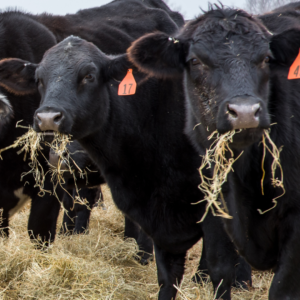 Feeding Cattle During Drought? 5 Cattle Nutrition Tips: Drought can be unpredictable. Set your herd up for success no matter what Mother Nature throws your way with these strategies!
Feeding Cattle During Drought? 5 Cattle Nutrition Tips: Drought can be unpredictable. Set your herd up for success no matter what Mother Nature throws your way with these strategies!
1. Extend pastures.
Your forage base is your most valuable resource; help your cattle make the most of it.
- Use strategic management practices to improve grazing distribution. By spreading cattle out, they’ll be more likely to graze underutilized areas.
- Position self-fed products in strategic locations, generally away from the water source, to spread out cows at pasture.
2. Early weaning calves.
Especially during short-term droughts, early weaning calves is a useful strategy to reduce cow nutrient requirements.
- During the latter part of lactation, calves demand a lot from cows. Early weaning calves can offer cows time to recover body condition before their next calving season – potentially improving rebreeding performance.1 Wean calves up to 60 days early, depending on drought severity.
- Feed weaned calves high-quality, complete starter feed when there is no roughage available.
- Before early weaning calves, it’s advisable to creep feed calves. Weaned calves need a high-quality, complete starter feed. Specific formulations are available to meet the needs of lightweight calves; visit with your local nutritionist to determine the best option.
3. Extend feedstuffs.
If pasture forage isn’t adequate, there are still options for feeding cattle during drought.
- Use high-quality cattle supplements during drought to make sure cattle nutrition is up to par.
- In extreme drought conditions, consider feeding cattle in confinement. If you have access to commodity feedstuffs and the management capability to provide a TMR, your local nutritionist can help develop a maintenance ration.
4. Cull low performing cattle.
Despite all the right management practices, sometimes liquidation is inevitable.
- Match herd numbers to your available cattle nutrition resources. Start by culling the lowest-performing cows in the herd, especially open cows.
- Use this as an opportunity to retain your best cows, then rebuild your herd in the genetic direction you desire when forages are back to normal post-drought.
5. Don’t forget the basics.
- Monitor natural water sources, such as ponds and tanks, to ensure cattle have adequate access to clean water.
- Test harvested forages for nutrient content and nitrate risk. Hay cut under drought conditions might contain high levels of nitrate and prussic acid.
- Beware of toxic plants, as cattle grazing short pasture are more likely to consume toxic plants. Talk to your local extension agent or forage specialist to identify potential toxic plant risk in your area.
Do you have more questions about Feeding Cattle During Drought? Visit North Fulton Feed. We have a great selection of cattle feed and knowledge to keep your herd happy and healthy.
Article Source: Purina Animal Nutrition
